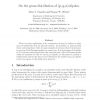Free Online Productivity Tools
i2Speak
i2Symbol
i2OCR
iTex2Img
iWeb2Print
iWeb2Shot
i2Type
iPdf2Split
iPdf2Merge
i2Bopomofo
i2Arabic
i2Style
i2Image
i2PDF
iLatex2Rtf
Sci2ools
COMBINATORICS
2007
2007
On the Genus Distribution of (p, q, n)-Dipoles
There are many applications of the enumeration of maps in surfaces to other areas of mathematics and the physical sciences. In particular, in quantum field theory and string theory, there are many examples of occasions where it is necessary to sum over all the Feynman graphs of a certain type. In a recent paper of Constable et al. on pp-wave string interactions, they must sum over a class of Feynman graphs which are equivalent to what we call (p, q, n)-dipoles. In this paper we perform a combinatorial analysis that gives an exact formula for the number of (p, q, n)-dipoles in the torus (genus 1) and double torus (genus 2).
| Added | 12 Dec 2010 |
| Updated | 12 Dec 2010 |
| Type | Journal |
| Year | 2007 |
| Where | COMBINATORICS |
| Authors | Terry I. Visentin, Susana W. Wieler |
Comments (0)

